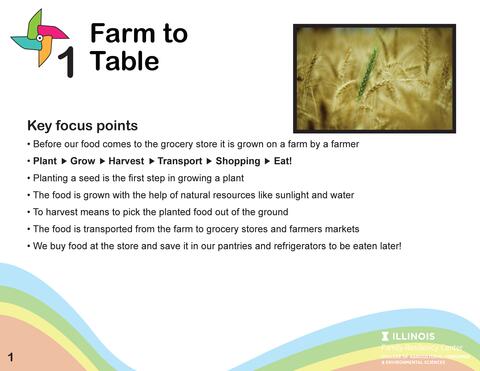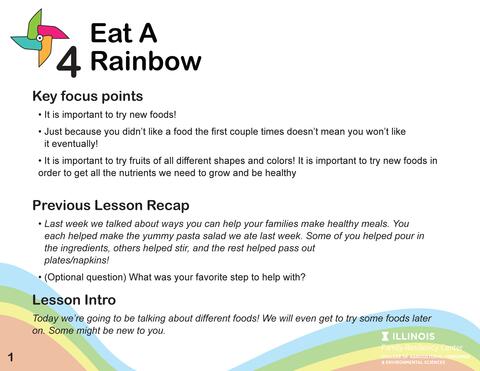Overview

The development of healthy habits in early life is key for families and children to set the stage for a lifetime of health and wellness. Schools and early-care settings can play an important role in educating children about nutrition, their bodies, and food sources.
A research team at the Family Resiliency Center has developed a healthy-habits curriculum for children ages 4 to 6, which seeks to increase awareness and knowledge of healthy routines—such as healthy eating habits and sleeping patterns—that can be implemented daily. The curriculum has been piloted at local elementary schools and pre-K programs (results indicate children increased their healthy habits knowledge) and has been reviewed for use by child care providers and afterschool community-based programs.
Purchase the Curriculum Box Set
The curriculum includes an overview booklet about the curriculum development, lesson timing and preparation, facilitator tips, alignment with Common Core Grade-K & NAEYC standards, and a suggested book list. The box set also includes facilitator guides and parent newsletters for all nine lessons, as well as accompanying documents for the lesson activities. Learn more.
SPROUTS Growing Healthy Habits Curriculum
These resources are designed for public use to expand the benefits of this FRC research and program development. You will find facilitator guides that can easily be adopted and used in ways that best suit your population and resources. Each lesson has a specific focus that incorporates hands-on activities and interactive book reading. Additionally, the lessons have printable activities and a podcast featuring FRC researchers and SPROUTS program developers. The lessons can be taught in succession, but that is not required. Additionally. individual lessons or activities can be used separately to encourage healthy habits for young children.

Lesson 1: Farm to Table
Children will learn where food comes from and gain an understanding of each step from the farming process to the food ending up on the table. Activities include an interactive crafting layout and planting radish seeds. Learn more.

Lesson 2: Food Groups and Grocery Shopping
Children will learn what types of food fall under each food group and how to make a balanced meal. Activities include a shopping experience in which children get to go shopping in a make-believe store to make a balanced meal. Learn more.

Lesson 3: Family Mealtimes and Cooking
Children will talk about the importance of family mealtimes and learn how they can help with dinner preparation at home. The lesson includes helping to make a dinner and share a family-style meal. Learn more.

Lesson 4: Eat a Rainbow
Children will learn about different types of fruits and vegetables and the importance of trying new things for health. The lesson offers an opportunity to try a "rainbow" of fruit options to experience what a variety of fruit tastes like. Learn more.

Lesson 5: Snacks
Children will learn the difference between snacks and meals and talk about healthy snacks. Activities include a “Snack Attack” bracket in which children can vote for the healthiest snacks. Learn more.

Lesson 6: Beverages
Children will learn about sugar in beverages. They will discover how healthy beverages give people nutrients to feel good and grow, while some beverages with too much sugar can make people tired or sick. Additionally, children will make a graph of a sugar cube to compare the amount of added sugar in different beverages. Learn more.

Lesson 7: Energy Balance
Children will learn how to determine which activities use more energy and how food intake needs to be balanced by energy expenditure. The lesson includes drawing and coloring foods consumed and favorite activities for energy expenditure. Learn more.

Lesson 8: Healthy Screen Time
Children will learn how screen time is related to health outcomes. Activities will include creating a personalized book for non-screen-time ideas. Children will get to create an "activity dice" they can roll to discover and choose non-screen-time activities. Learn more.

Lesson 9: Healthy Sleep Habits
Children will learn about the importance of healthy bedtime routines. The lesson includes crafts and a worksheet based on bedtime habits. Learn more.
Additional Resources
- Mission and Purpose Statement
- Meet the SPROUTS team
- SPROUTS Curriculum Development Timeline (Spring 2013 - Fall 2018)
- Facilitator Tips: How to Get the Most from this Curriculum
- SPROUTS Lesson Overviews
- Preparation Information for SPROUTS Lessons
- Alignment with Education Standards (Common Core & NAEYC)
- Recommended Books for SPROUTS Curriculum
Research Team
- Barbara Fiese, Ph.D., Former Director, Family Resiliency Center, Human Development and Family Studies
- Brenda Koester, MS, Associate Director, Family Resiliency Center, Human Development and Family Studies
Contact:
Brenda Koester
217-244-6486
bkoester@illinois.edu
Funding
This project is supported by the Christopher Family Foundation Food and Family Program.
Please Note
This curriculum is meant to be used in ways that are best suited for your population and resources. However, we ask that you do not edit the curriculum itself and please provide reference to the Family Resiliency Center at the University of Illinois when using the materials.
Copyright 2018 Board of Trustees of the University of Illinois. This work is made available under a Creative Commons Attribution-NonCommercial-No Derivatives 4.0 license (international) or CC BY ND NC, https://creativecommons.org/licenses/by-nc-nd/4.0/legalcode, by the Board of Trustees of the University of Illinois.